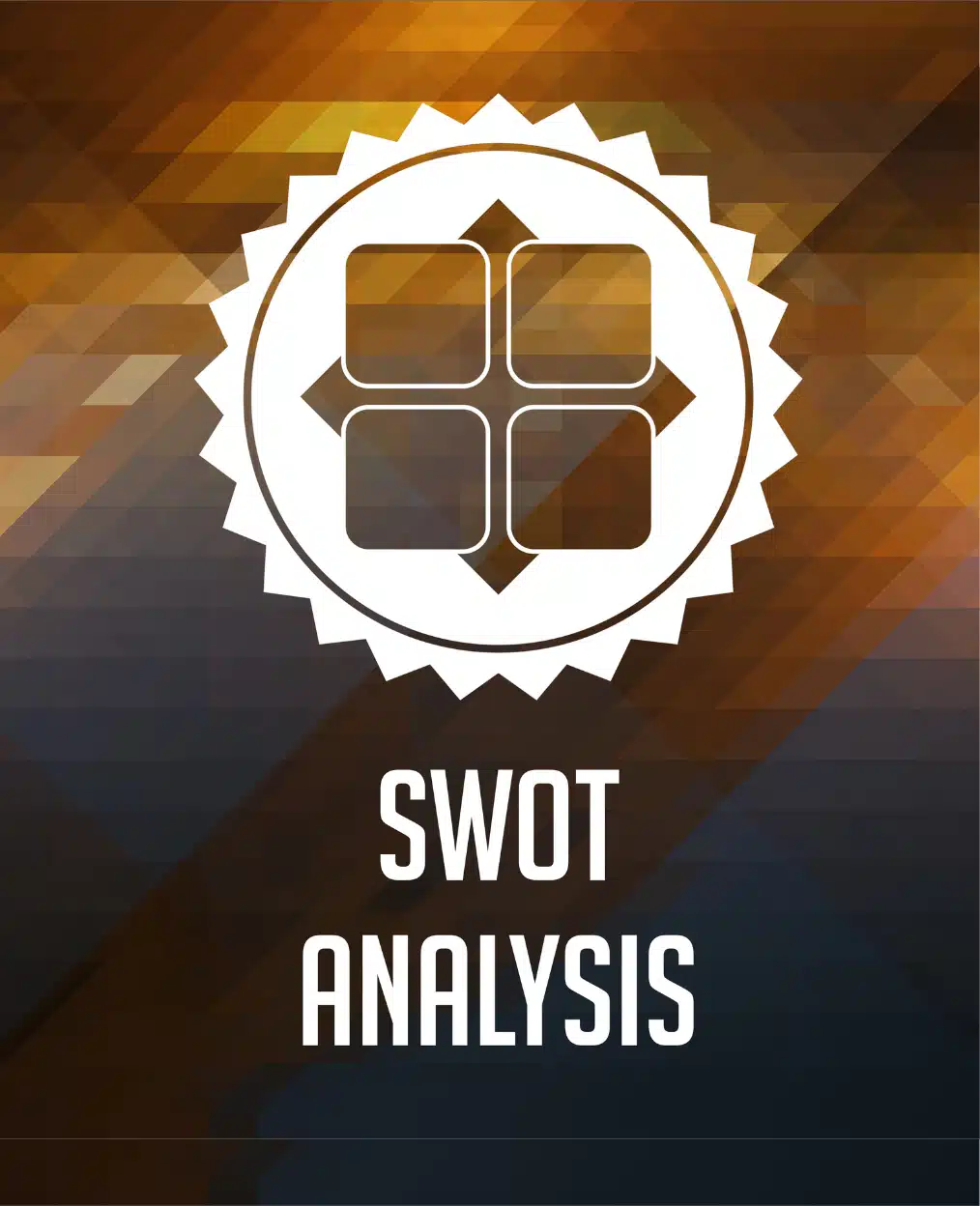SWOT Analysis Definition
SWOT Analysis (Strengths, Weaknesses, Opportunities, and Threats) is a popular market research tool used to evaluate a company or organization’s internal and external environment.
It is a framework that helps to identify and analyze a company’s strengths and weaknesses, as well as external opportunities and threats.
The strengths of a company refer to its internal capabilities and resources that give it a competitive advantage over its competitors. For example, a company may have a strong brand, unique products, or a skilled workforce.
Weaknesses, on the other hand, refer to the internal limitations or shortcomings of a company that can hinder its performance and competitiveness. For example, a company may have a weak financial position or lack of innovation.
Opportunities refer to external factors that a company can take advantage of to grow and improve its performance.
For example, a company may have the opportunity to enter new markets, launch new products, or acquire other companies.
Threats refer to external factors that can harm a company’s performance and competitiveness. For example, a company may face competition from new entrants, changing market conditions, or economic downturns.
In the context of competitor analysis, SWOT can help a company to identify its competitors’ strengths and weaknesses, and understand the opportunities and threats that they may face.
This information can be used to develop strategies to take advantage of the opportunities and mitigate the threats. It can also help a company to identify potential acquisition targets, or to develop plans to defend against a competitor’s strengths.
Identifying Strengths
To conduct a SWOT, begin by identifying the company’s strengths, which are internal factors that give it an advantage over competitors. These could include a strong brand, experienced management team, proprietary technology, loyal customer base, or a strong financial position.
For example, a strength of a coffee shop might be its prime location in a high-traffic area or its reputation for serving high-quality coffee. A software company might have a strength in its proprietary technology that sets it apart from competitors.
Identifying Weaknesses
Next, identify the company’s weaknesses, which are internal factors that may hold it back from achieving its goals. These could include a lack of resources, outdated technology, poor management, low employee morale, or a lack of diversification in products or services.
For example, a weakness of a coffee shop might be a limited menu or lack of seating space. A software company might have a weakness in its lack of mobile app development capabilities.
Identifying Opportunities
After identifying internal factors, turn your attention to external factors. Opportunities are external factors that the company could take advantage of to grow and improve. These could include a growing market, new technologies, changes in regulations, or partnerships with other companies.
For example, a coffee shop might have the opportunity to expand into delivery or online ordering services, or to add more seating space. A software company might have the opportunity to expand into a new market or develop a new product line.
Identifying Threats
Finally, identify the threats that external factors pose to the company. These could include changes in consumer behavior, new competitors, economic downturns, or changes in regulations.
For example, a coffee shop might be threatened by the emergence of new coffee shops in the area or a decrease in consumer spending due to an economic downturn. A software company might be threatened by new competitors entering the market or changes in regulations that affect its operations.
Using the SWOT Analysis for decision making
Once you have identified all of the factors in your SWOT, you can begin to strategize on how to make the most of your strengths, improve upon your weaknesses, capitalize on opportunities, and mitigate threats. This can help you make better decisions, such as where to allocate resources, which products or services to focus on, and how to position your company in the marketplace.
For example, a coffee shop might use its SWOT analysis to decide to focus on expanding its delivery services and online ordering capabilities to capitalize on the opportunity, while also working to improve its menu offerings to address its weakness.
A software company might use its SWOT analysis to decide to invest in developing a mobile app to address its weakness and capitalize on the opportunity in the mobile market.
SWOT Analysis examples in different businesses
SWOT for a CBD oil business in California
Strengths:
- The strength of a CBD oil business in California would be its location in a state that is considered a leader in the CBD market. California has a large population of potential customers, and this could give the business a competitive advantage.
- The popularity of CBD oil is increasing and more people are turning towards it for its potential health benefits. This creates a large market for the business to tap into.
- The business can differentiate itself by offering a wide range of products such as CBD oil, capsules, gummies, and lotions. This will help it to cater to a wider audience and increase its revenue potential.
- A strong online presence and a good reputation can help the business to attract new customers and retain existing ones.
Weaknesses:
- The weaknesses of a CBD oil business in California would be the strong competition with other CBD oil companies. This could make it difficult for the business to stand out and attract customers.
- Limited consumer knowledge and understanding of CBD oil can lead to skepticism. This could make it challenging to sell the products and educate customers about the benefits of CBD oil.
- Stringent federal regulations and compliance requirements can be costly and time-consuming for the business to comply with.
- Reliance on a few suppliers for raw materials can also be a weakness as it may lead to a lack of control over the quality and price of the raw materials.
Opportunities:
- Expansion to other states and international markets can provide a significant growth opportunity for the business. This would increase its revenue potential and help it to tap into new markets.
- Developing new products such as pet supplements and skin care products can help the business to diversify its product line and attract new customers.
- Creating partnerships with other companies in the health and wellness industry can help the business to expand its reach and increase its visibility.
- Education and awareness campaigns to educate customers about the benefits of CBD oil can help to build trust and credibility with potential customers.
Threats:
- Fluctuations in the price of raw materials can affect the business’s profitability and make it difficult to predict costs.
- Possible changes in government regulations regarding the sale and use of CBD oil could have a significant impact on the business.
- Negative public perception or misinformation about CBD oil could lead to a decrease in customer demand.
- Lawsuits from other companies or individuals claiming infringement on their patents or trademarks could be costly and time-consuming for the business.
Overall, a SWOT analysis helps a business to understand its internal and external environment, identify its strengths and weaknesses, and identify opportunities and threats. It enables the business to make informed decisions and develop strategies to take advantage of opportunities and mitigate threats.
SWOT Analysis for a restaurant in New York
A SWOT for a restaurant in New York would involve identifying and analyzing the restaurant’s internal strengths and weaknesses, as well as external opportunities and threats.
Strengths:
- Location: The restaurant is located in a bustling city like New York City, which provides a large population of potential customers and a high level of tourist traffic. This gives the restaurant a competitive advantage over restaurants located in less populated areas.
- Menu: The restaurant offers a unique and high-quality menu that sets it apart from other restaurants in the area. This can attract customers who are looking for something different and are willing to pay a premium for it.
- Reputation: The restaurant has a positive reputation and a strong customer base. This can attract new customers through word-of-mouth recommendations and increase customer loyalty.
- Staff: The restaurant has experienced and skilled staff that can provide excellent customer service and ensures that the restaurant runs smoothly.
- Branding: The restaurant has a strong brand identity that is well-known and recognized by customers.
Weaknesses:
- Operating costs: The high operating costs of running a restaurant in New York City, such as the cost of real estate and labor, can be a significant financial burden on the restaurant. This can make it difficult to achieve profitability.
- Competition: The restaurant faces tough competition from other restaurants in the area, which can make it difficult to attract and retain customers.
- Seating capacity: The restaurant may have limited seating capacity, which can limit the number of customers it can serve at any given time.
- Dependence on regular customers: The restaurant may be dependent on a small group of regular customers, which could be risky if these customers stop visiting the restaurant.
Opportunities:
- Expansion: The restaurant has the opportunity to expand to other locations in New York City or other major cities, which can increase its revenue potential and help it to tap into new markets.
- Delivery and takeout: The restaurant can offer delivery and takeout services to attract customers who prefer to eat at home.
- Online ordering: The restaurant can create an online ordering system, which can help to attract customers who prefer to order online
- Food delivery apps: The restaurant can partner with local food delivery apps like Grubhub, DoorDash, and UberEats to expand its reach and visibility.
- Social media: The restaurant can create a strong social media presence to attract new customers and engage with existing ones.
Threats:
- Economic downturns: Economic downturns can lead to a decrease in consumer spending, which can affect the restaurant’s revenue.
- New restaurants: The opening of new restaurants in the area can increase competition and make it difficult for the restaurant to attract and retain customers.
- Government regulations: Government regulations and restrictions on the restaurant industry can be costly and time-consuming to comply with.
- Negative reviews: Negative reviews or publicity on social media and review websites can harm the restaurant’s reputation and lead to a decrease in customer demand.
Overall, a SWOT analysis provides a restaurant in New York City with a comprehensive understanding of its internal and external environment. It helps the restaurant to identify its strengths and weaknesses and identify opportunities and threats. It enables the restaurant to make informed decisions and develop strategies to take advantage of opportunities and mitigate threats.
SWOT Analysis for a digital marketing agency
A SWOT analysis for a digital marketing agency would involve identifying and analyzing the agency’s internal strengths and weaknesses, as well as external opportunities and threats.
Strengths:
- Expertise: The agency has a team of experienced and skilled professionals who are well-versed in digital marketing techniques and technologies. This can give the agency a competitive advantage over its rivals and help it to deliver effective and impactful campaigns.
- Wide range of services: The agency offers a wide range of digital marketing services, such as SEO, PPC, social media marketing, and content marketing. This can attract a diverse range of clients and help the agency to increase its revenue potential.
- Strong portfolio: The agency has a strong portfolio of successful campaigns and satisfied clients, which can help it to attract new clients and build credibility.
- Technological advancements: The agency keeps up with the latest technological advancements in the field of digital marketing, which allows it to provide innovative and effective services to its clients.
Weaknesses:
- Limited geographic reach: The agency may have limited geographic reach and may only serve clients in a specific region. This can limit its revenue potential and make it difficult to scale.
- Dependence on a small number of clients: The agency may be dependent on a small number of clients, which can be risky if these clients leave or reduce their business with the agency.
- High employee turnover: The agency may have high employee turnover, which can lead to a loss of expertise and experience, and can make it difficult to maintain consistency in the agency’s services.
Opportunities:
- Growing digital marketing industry: The digital marketing industry is growing rapidly, which creates opportunities for the agency to increase its revenue and market share.
- New technologies: The agency has the opportunity to adopt new technologies and techniques in digital marketing, such as artificial intelligence and virtual reality, which can help it to differentiate itself from its competitors and provide innovative services to its clients. Jasper AI is one of those tools that can generate creative content with minimum effort.
- International expansion: The agency has the opportunity to expand its operations to other countries, which can help it to tap into new markets and increase its revenue potential.
Threats:
- Intense competition: The agency faces intense competition from other digital marketing agencies, which can make it difficult to attract and retain clients.
- Economic downturns: Economic downturns can lead to a decrease in consumer spending, which can affect the agency’s revenue.
- Changing consumer behavior: Changing consumer behavior, such as the shift to mobile devices and increased use of ad blockers, can make it difficult for the agency to deliver effective campaigns and reach its target audience.
What are the necessary steps for writing a Powerful SWOT analysis?
Writing a good SWOT involves several steps:
- Define the scope of the analysis: Clearly define the scope of the analysis by identifying the specific area or aspect of the business that you want to evaluate. For example, if you’re conducting a SWOT analysis for a restaurant, you may want to focus on its menu, location, or customer service.
- Gather information: Gather information on the company’s internal strengths and weaknesses, as well as external opportunities and threats. This information can come from various sources, such as financial reports, market research, customer feedback, and industry trends.
- Identify strengths: Identify the company’s internal strengths, such as its strong brand, loyal customer base, or innovative products.
- Identify weaknesses: Identify the company’s internal weaknesses, such as its high operating costs, lack of diversification, or outdated technology.
- Identify opportunities: Identify external opportunities, such as new markets, emerging technologies, or changes in consumer behavior.
- Identify threats: Identify external threats, such as intense competition, economic downturns, or changing regulations.
- Organize the information: Organize the information into a clear and logical format, such as a matrix or chart, to make it easy to understand and interpret.
- Evaluate the information: Evaluate the information by analyzing the impact of the strengths, weaknesses, opportunities, and threats on the company’s performance and competitiveness.
- Develop strategies: Develop strategies to take advantage of the opportunities and mitigate the threats. Identify the best ways to address the weaknesses and build on the strengths.
- Review the analysis: Regularly review the analysis and update it as needed to ensure that it remains accurate and relevant.
By following these steps, you can write a good SWOT analysis that provides a comprehensive understanding of a company’s internal and external environment and enables it to develop effective strategies that can help it to grow and improve its performance.
A quick overview of the topics covered in this article.
Latest Posts
December 21, 2025
December 21, 2025
Subscribe to our newsletter
Get valuable insights and business guidance sent to your email.








